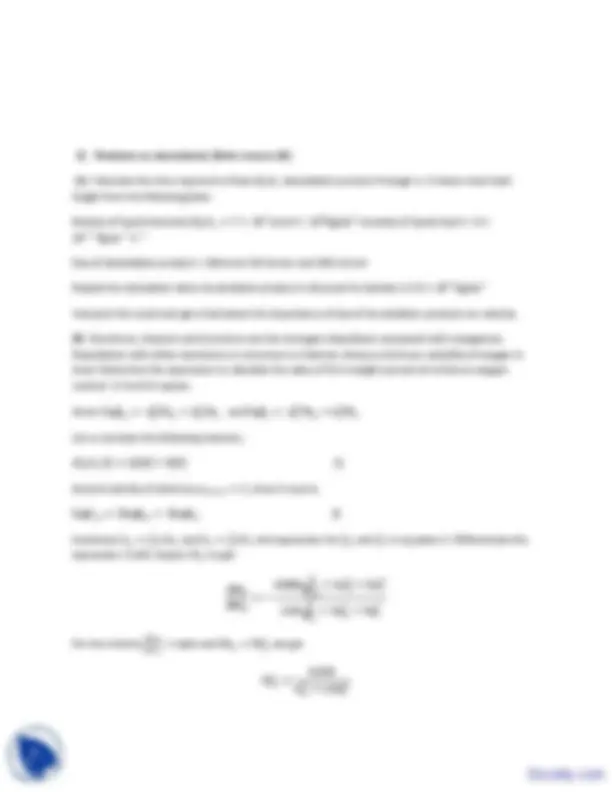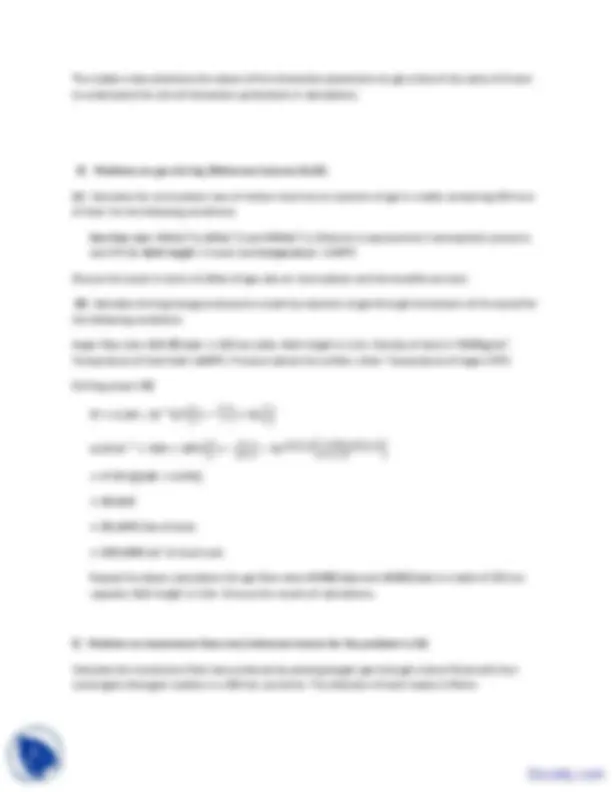





Study with the several resources on Docsity

Earn points by helping other students or get them with a premium plan


Prepare for your exams
Study with the several resources on Docsity

Earn points to download
Earn points by helping other students or get them with a premium plan
Community
Ask the community for help and clear up your study doubts
Discover the best universities in your country according to Docsity users
Free resources
Download our free guides on studying techniques, anxiety management strategies, and thesis advice from Docsity tutors
The major points which I found very informative are:Exercise in Ladle Metallurgy, Desulphurization Modes, Deoxidation, Gas Stirring, Momentum Flow Rate, Partition Coefficient, Sulphur Partition Coefficient, Powder Injection Rate, Circulation of Molten Steel
Typology: Exercises
1 / 5

This page cannot be seen from the preview
Don't miss anything!




Lecture 30: Exercise in ladle metallurgy
Contents
Exercise on desulphurization
Exercise on degassing
Exercise on deoxidation
Exercise on gas stirring
Exercise on momentum flow rate
1) Problem of desulphurization
(A) Calculate K
s
for a synthetic slag composed of X
caO
= 0. 65 and X
Al 2
O 3
= 0. 35. The slag is
contact with molten steel at temperature T. with dissolved aluminum 0. 01 wt %. In slag activity
of alumina is 0.38. use T = 1773 K and 1850 K and interpret the results.
log C s
by equation 4 of lecture 22 = - 1.96.
log K s
= log C
s
20397
1773
2
3
log 0. 01 +
1
3
log 0. 38 − 5. 482
s
= 387 at T = 1773 K
s
= 130 at T = 1850 K
We note the partition coefficient is higher at 1773K as compared with that at 1850K. Ws can conclude
that lower tempearure favours desulphurization.
(B) Discuss the transitory and permanent contact mode of desulphurization based on the following
calculations: Molten steel is desulphurised by injecting powder at the rate of 4 kg/ton. The
partition coefficient of sulphur is 50. Now we select a slag whose partition coefficient is 400. We
also increase the powder injection rate in one case to 4 kg/ton and in other case to 6 kg/ton.
What will be the effect of a) sulphur partition coefficient and b) powder injection rate on
desulphurization modes
Note a Similar problem is solved in lecture 23.
2) Problem on degassing
(A) In RH degassing, liquid steel is circulated through the vacuum chamber in order to lower the
hydrogen content from 6ppm to 3ppm in 15 minutes. Molten steel attains equilibrium with to hydrogen.
Given: temperature = 1600 ℃
Molten steel in ladle = 60 tons.
Pressure inside vacuum chamber = 0. 2 tor r
The molten steel analyzes C = 0. 06 %, Cr = 6 %, Ti = 0. 5 %, Ni 2 % and rest iron.
Interaction parameter e
H
C
= 0. 045 , e
H
Cr
= 0. 005 and e
H
Ti
Calculate rate of circulation of molten steel.
Solution
m
t
ln
[PPmH ]
1
−[PPmH ]
∗
[PPmH ]
2
−[PPmH ]
∗
log f
H
f H
[PPmH
∗
] = k
H
pH
2
log k H
1905
T
k
H
PPmH
∗
f
H
− 3
60
15
ln
6 − 0. 465
3 − 0. 465
= 3. 12 tonnes/min Ans.
(B) Repeat the above calculations when T = 1650 ℃ and When pressure inside the chamber
= 0. 1 Tor r
Discuss the results in terms of technology development and requirements (refer lecture 25,26)
The readers may substitute the values of the interaction parameters to get a feel of the value of Al and
to understand the role of interaction parameters in calculations.
4) Problems on gas stirring (Reference lectures 21,22)
(A) Calculate the recirculation rate of molten steel due to injection of gas in a ladle containing 250 tons
of steel for the following conditions:
Gas flow rate : 400 m
3
/s, 600 m
3
/s and 800 m
3
/s. (Volume is expressed at 1 atmospheric pressure
and 273 K). Bath height : 3 meter and temperature 1200 ℃
Discuss the result in terms of effect of gas rate on recirculation and the benefits accrued.
(B) Calculate stirring energy produced in a bath by injection of gas through the bottom of the vessel for
the following conditions:
Argon flow rate: 500 Nl/min in 100 ton ladle. Bath height is 1.2m. Density of steel is 7000 kg/m
3
Temperature of steel bath 1600 ℃. Pressure above the surface =1bar. Temperature of argon 25 ℃.
Stirring power (W)
− 3
273
T
� + ln
P
1
P
2
− 3
273
1873
� − ln
5
5
= 83. 64 W/ton of steel
= 585. 48 W/m
3
of steel melt.
Repeat the above calculations for gas flow rates 400 Nl/min and 600 Nl/min in a ladle of 150 ton
capacity. Bath height is 1.5m. Discuss the results of calculations.
5) Problem on momentum flow rate (reference lecture for the problem is 13)
Calculate the momentum flow rate produced by passing oxygen gas through a lance fitted with four
convergent-divergent nozzles in a 300 ton converter. The diameter of each nozzle is 45mm.
Hint: Calculate P O
by equation 6 and use equation 5 to calculate momentum flow rate. Use surrounding
pressure 1.013 x 10
5
N/m
2
The lance distance to start the blow is 3m upto 25% of the blow time which is then decreased to 2m for
25% to 75% of the blow time. Between 75% and upto the end the lance distance id decreased further to
1.5m. Calculate the depth of penetration of gas jet and discuss the nature of blow and the associated
physico-chemical reactions as a function of lance distance. Include in your calculation the depth of
penetration of gas jet.
Hint Calculate dimensionless momentum flow rate from equation 8 and depth of gas jet penetration
from equation